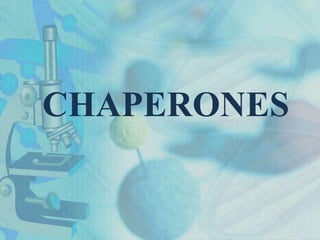Molecular chaperones are protein families vital for correct protein folding and preventing aggregation, with various specificities and functions. They are produced in response to stress, particularly heat, and play roles in both folding and degradation processes to maintain cellular homeostasis. Chaperones contribute to disease mechanisms, with disruptions in their function linked to conditions like Alzheimer's disease.


























![Small heat shock
proteins (hsp25)
[holders]
Hsp25 is the second
largest of 16
identifiable small heat
shock proteins in the
nematode.
Protect against
cellular stress
Prevent aggregation
in the lens (cataract)
Hsp90 ATPase [holder]
Hsp90 is a specialized
chaperone that assists
in the maturation of
client proteins.
These proteins
include over a hundred
transcription factors
and kinases, such as
steroid receptors](https://image.slidesharecdn.com/chaperones1-171230142538/85/Chaperones-27-320.jpg)



![Hsp100 (Clp) ATPase [unfolder]
• The HSP100/Clp proteins are a newly discovered
family, promotion of proteolysis of specific cellular
substrates and regulation of transcription.
• Common ability is to disassemble higher-order protein
structures](https://image.slidesharecdn.com/chaperones1-171230142538/85/Chaperones-31-320.jpg)


















